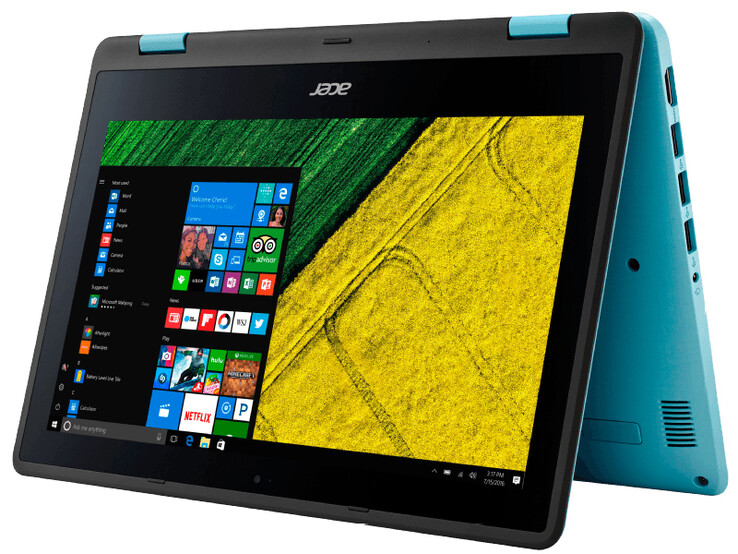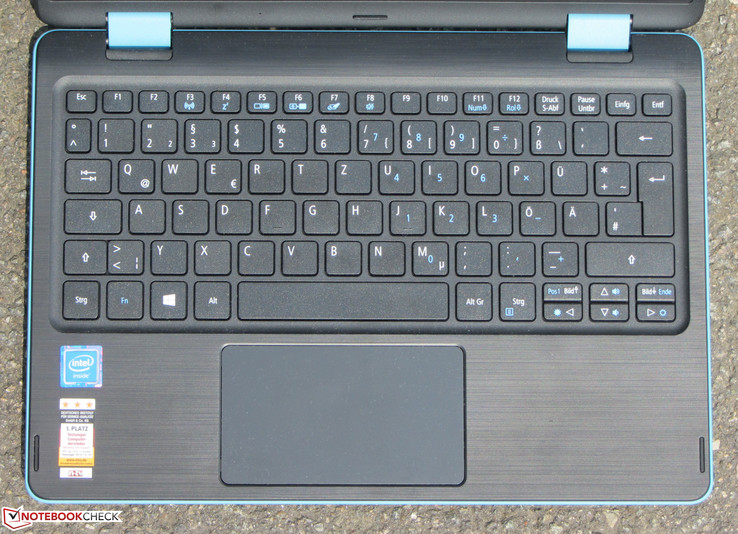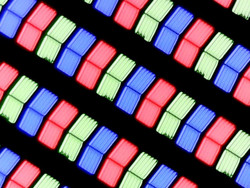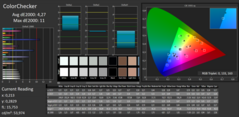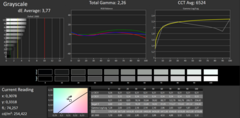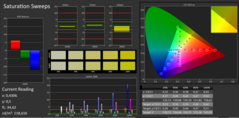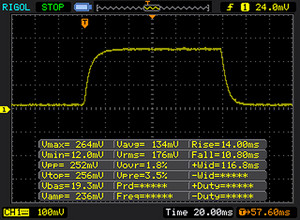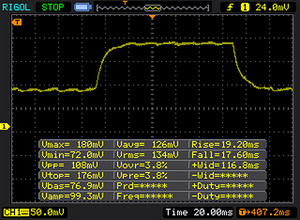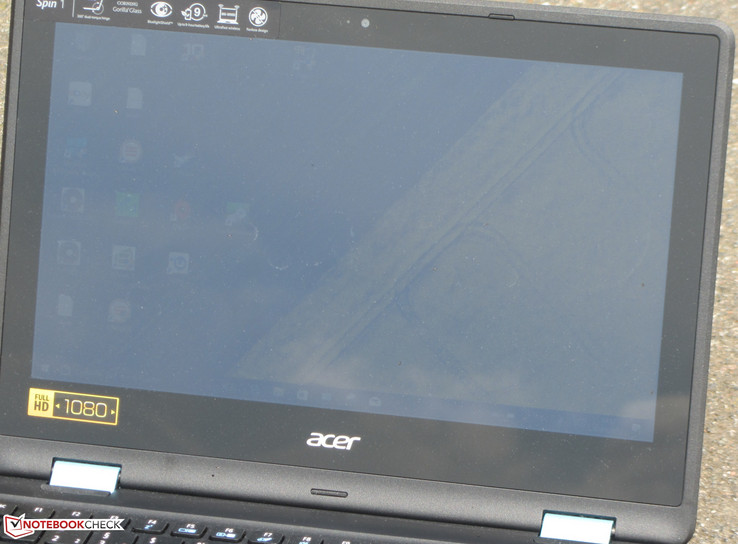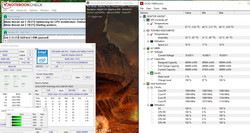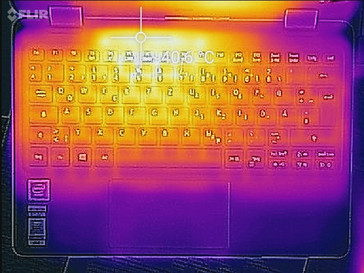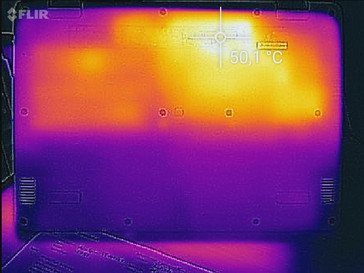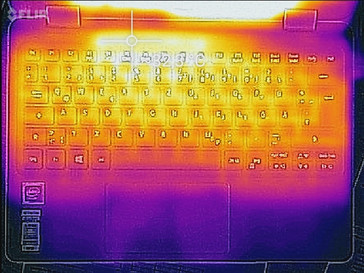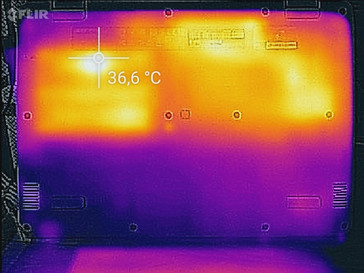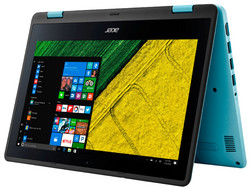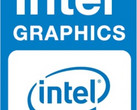Acer Spin 1 (N3450, FHD) Convertible Review

For the original German review, see here.
After the Spin 5 and the Spin 7, we are now testing the Spin 1, the smallest and one of the weakest models of Acer's convertible series. The 11.6-inch model is driven by a Celeron quad-core processor of the Apollo Lake generation. Competitors of the convertible include devices such as the Asus VivoBook Flip 12 TP203NAH, the HP Pavilion 11 x360, the Medion Akoya E2215T, and the Dell Latitude 3189.
Case and Features
Acer has packed the technology of the Spin 1 into a two-tone plastic case. The back of the lid and bottom of the case are colored in a turquoise/light blue tone. Both elements also have a linen texture. The display frame and the top of the base unit are black. The top of the base also has a texture simulating brushed metal. The case is well-built and does not show any faults in that respect. However, the base unit could have been slightly stiffer. The battery is built-in, and the computer does not have a maintenance flap.
There are no surprises in terms of the connections. The convertible offers three Type-A USB ports (1x USB 3.1 Gen 1, 2x USB 2.0) and there is a video port (HDMI). Acer places the ports on both sides towards the back, which leaves the space next to the palm rests free from cables.
The WLAN module of the Spin 1 has a Qualcomm (QCA9377) chip, which, as well as the 802.11a/b/g/h/n WLAN standards, also supports the fast ac standard. The transfer speeds we measured under optimal conditions (no other WLAN devices in close proximity, close distance between notebook and server PC) were good.
Connections
| SD Card Reader | |
| maximum SDCardreader Maximum Transfer Rate | |
| average SDCardreader Average Transfer Rate |
| Networking | |
| iperf3 transmit AX12 | |
| Dell Latitude 3189 | |
| Asus VivoBook Flip 12 TP203NAH-BP049T | |
| Acer Spin 1 SP111-31-C79E | |
| iperf3 receive AX12 | |
| Dell Latitude 3189 | |
| Asus VivoBook Flip 12 TP203NAH-BP049T | |
| Acer Spin 1 SP111-31-C79E | |
Input Devices
Acer has provided the Spin 1 with a chicklet keyboard without backlight. The flat, slightly roughed keys have a short stroke and a pronounced pressure point that knows how to please. While typing, the keyboard yields slightly - more in the right half than in the left. This was not problematic. Overall, Acer delivers a very decent keyboard here, which is also made for frequent writing work.
The multitouch-capable ClickPad occupies an area of about 10.5 x 6 cm (~4.1 x 2.4 in). This offers plenty of space for gesture controls. The smooth surface of the pad does not prevent the fingers from sliding. The pad also reacts to input at the corners. It has a short stroke and a clear pressure point.
The touchscreen of the convertible supports 10 touch points. It reacts to inputs promptly, and can be operated with the fingers as well as an active pen, which would have to be purchased separately.
Display
The 11.6-inch touchscreen display of the Spin 1 has a native resolution of 1920x1080 pixels and offers a good contrast (1195:1). The maximum brightness of the display (246.9 cd/m2) could have been higher, since we can assume that the device is used in various locations under various light conditions. Positive: at no time does the screen show any PWM flickering.
| |||||||||||||||||||||||||
Brightness Distribution: 86 %
Center on Battery: 251 cd/m²
Contrast: 1195:1 (Black: 0.21 cd/m²)
ΔE ColorChecker Calman: 4.27 | ∀{0.5-29.43 Ø4.77}
ΔE Greyscale Calman: 3.77 | ∀{0.09-98 Ø5}
72% sRGB (Argyll 1.6.3 3D)
47% AdobeRGB 1998 (Argyll 1.6.3 3D)
51.4% AdobeRGB 1998 (Argyll 3D)
72.6% sRGB (Argyll 3D)
49.67% Display P3 (Argyll 3D)
Gamma: 2.26
CCT: 6524 K
| Acer Spin 1 SP111-31-C79E IPS, 1920x1080, 11.6" | Asus VivoBook Flip 12 TP203NAH-BP049T IPS, 1366x768, 11.6" | Dell Latitude 3189 IPS, 1366x768, 11.6" | Medion Akoya E2215T IPS, 1920x1080, 11.6" | HP Pavilion 11-k103ng x360 IPS, 1366x768, 11.6" | |
|---|---|---|---|---|---|
| Display | -10% | -9% | -2% | -8% | |
| Display P3 Coverage (%) | 49.67 | 44.23 -11% | 44.96 -9% | 48.12 -3% | 45.21 -9% |
| sRGB Coverage (%) | 72.6 | 66.3 -9% | 67.3 -7% | 71.7 -1% | 67.8 -7% |
| AdobeRGB 1998 Coverage (%) | 51.4 | 45.73 -11% | 46.49 -10% | 49.78 -3% | 46.73 -9% |
| Response Times | -6% | -19% | 3% | 26% | |
| Response Time Grey 50% / Grey 80% * (ms) | 36 ? | 39 ? -8% | 40 ? -11% | 31 ? 14% | 18.8 ? 48% |
| Response Time Black / White * (ms) | 24 ? | 25 ? -4% | 30.4 ? -27% | 26 ? -8% | 23.2 ? 3% |
| PWM Frequency (Hz) | 50 ? | ||||
| Screen | 10% | 18% | -2% | 2% | |
| Brightness middle (cd/m²) | 251 | 253 1% | 291 16% | 338 35% | 194 -23% |
| Brightness (cd/m²) | 247 | 245 -1% | 284 15% | 309 25% | 186 -25% |
| Brightness Distribution (%) | 86 | 65 -24% | 92 7% | 76 -12% | 86 0% |
| Black Level * (cd/m²) | 0.21 | 0.17 19% | 0.16 24% | 0.39 -86% | 0.22 -5% |
| Contrast (:1) | 1195 | 1488 25% | 1819 52% | 867 -27% | 882 -26% |
| Colorchecker dE 2000 * | 4.27 | 3.17 26% | 3.4 20% | 3.94 8% | 3.06 28% |
| Colorchecker dE 2000 max. * | 11 | 8.13 26% | 9.6 13% | 9.96 9% | 8.81 20% |
| Greyscale dE 2000 * | 3.77 | 2 47% | 1.8 52% | 2.54 33% | 1.42 62% |
| Gamma | 2.26 97% | 2.43 91% | 2.14 103% | 2.38 92% | 2.34 94% |
| CCT | 6524 100% | 6850 95% | 6544 99% | 6902 94% | 6432 101% |
| Color Space (Percent of AdobeRGB 1998) (%) | 47 | 42 -11% | 42.8 -9% | 46 -2% | 42.98 -9% |
| Color Space (Percent of sRGB) (%) | 72 | 66 -8% | 67 -7% | 71 -1% | 67.56 -6% |
| Total Average (Program / Settings) | -2% /
4% | -3% /
8% | -0% /
-1% | 7% /
3% |
* ... smaller is better
Screen Flickering / PWM (Pulse-Width Modulation)
| Screen flickering / PWM not detected | ||
In comparison: 53 % of all tested devices do not use PWM to dim the display. If PWM was detected, an average of 8091 (minimum: 5 - maximum: 343500) Hz was measured. | ||
Display Response Times
| ↔ Response Time Black to White | ||
|---|---|---|
| 24 ms ... rise ↗ and fall ↘ combined | ↗ 14 ms rise | |
| ↘ 10 ms fall | ||
| The screen shows good response rates in our tests, but may be too slow for competitive gamers. In comparison, all tested devices range from 0.1 (minimum) to 240 (maximum) ms. » 53 % of all devices are better. This means that the measured response time is worse than the average of all tested devices (20.2 ms). | ||
| ↔ Response Time 50% Grey to 80% Grey | ||
| 36 ms ... rise ↗ and fall ↘ combined | ↗ 19 ms rise | |
| ↘ 17 ms fall | ||
| The screen shows slow response rates in our tests and will be unsatisfactory for gamers. In comparison, all tested devices range from 0.165 (minimum) to 636 (maximum) ms. » 49 % of all devices are better. This means that the measured response time is worse than the average of all tested devices (31.6 ms). | ||
Acer provides the Convertible with an IPS panel that has stable viewing angles. Thus the screen can be read from any position. In most cases, the low display brightness and the reflective screen surface prevent outdoor use. At most, the device can be used in shady surroundings or when the sky is overcast.
Performance
Acer's 11.6-inch convertible offers sufficient performance for applications in the office and Internet areas. Our test device can be purchased for about 425 Euros (~$480; in the US a similar model with the Celeron N3350, 4GB DDR3L, and 32GB Storage is currently available for $300). Other feature variants are available with prices starting at 300 Euros (~$340).
Processor
The Spin 1 has Intel's Celeron N3450 (Apollo Lake) quad-core processor on board. The CPU is one of the energy efficient models. A TDP of only 6 watts allows passive cooling of the chip, which is also done here. The processor operates at a basic speed of 1.1 GHz, which can be increased via turbo up to 2.2 GHz. The turbo is used in both mains and battery operations. However, in the Multithread tests of the Cinebench benchmarks, it is only used sparingly. It runs though these benchmarks with 1.5 to 1.6 GHz.
This speed range can also be maintained over prolonged periods of time. We test this by running the Multithread test of Cinebench R15 for about 30 minutes in a constant loop. The results remain consistently at the same level, and there is no drop in performance.
| Geekbench 4.0 | |
| 64 Bit Multi-Core Score | |
| Asus VivoBook Flip 12 TP203NAH-BP049T | |
| Acer Spin 1 SP111-31-C79E | |
| Acer Swift 1 SF114-31-P6F6 | |
| 64 Bit Single-Core Score | |
| Asus VivoBook Flip 12 TP203NAH-BP049T | |
| Acer Spin 1 SP111-31-C79E | |
| Acer Swift 1 SF114-31-P6F6 | |
| Geekbench 4.4 | |
| 64 Bit Multi-Core Score | |
| Asus VivoBook Flip 12 TP203NAH-BP049T | |
| Acer Spin 1 SP111-31-C79E | |
| 64 Bit Single-Core Score | |
| Asus VivoBook Flip 12 TP203NAH-BP049T | |
| Acer Spin 1 SP111-31-C79E | |
System Performance
The system runs smoothly and we did not encounter any problems. The built-in processor offers sufficient computing power for applications in the office and Internet areas. The result in the PC Mark 8 benchmark corresponds to the performance capabilities of the SoC. By switching the HDD for an SSD, the overall performance could be increased. This would make the system react quicker and the loading times would decrease. It is not possible to increase the performance by activating the dual-channel mode, since the notebook has only one memory storage slot.
| PCMark 8 Home Score Accelerated v2 | 1530 points | |
| PCMark 10 Score | 1181 points | |
Help | ||
| PCMark 8 - Home Score Accelerated v2 | |
| Dell Latitude 3189 | |
| Asus VivoBook Flip 12 TP203NAH-BP049T | |
| HP Pavilion 11-k103ng x360 | |
| Acer Spin 1 SP111-31-C79E | |
| Medion Akoya E2215T | |
Storage Solution
A conventional 2.5-inch hard drive by Toshiba has found its way into the Spin 1. It offers 500 GB of storage and spins at 5400 RPM. The transfer rates of the HDD are at a normal level for 5400-RPM models.
| Acer Spin 1 SP111-31-C79E Toshiba MQ01ABF050 | Asus VivoBook Flip 12 TP203NAH-BP049T Seagate Mobile HDD 1TB ST1000LM035 | Dell Latitude 3189 Liteonit CV3-8D128 | Medion Akoya E2215T 64 GB eMMC Flash | HP Pavilion 11-k103ng x360 Hitachi Travelstar Z5K500 HTS545050A7E680 | |
|---|---|---|---|---|---|
| CrystalDiskMark 3.0 | -28% | 3912% | 729% | -7% | |
| Read Seq (MB/s) | 109.1 | 53.9 -51% | 408.4 274% | 169.6 55% | 106 -3% |
| Write Seq (MB/s) | 107.3 | 66.4 -38% | 214.3 100% | 39.77 -63% | 106.1 -1% |
| Read 512 (MB/s) | 35.89 | 22.62 -37% | 243.7 579% | 155.3 333% | 33.53 -7% |
| Write 512 (MB/s) | 45.28 | 67.3 49% | 170.6 277% | 27.45 -39% | 39.03 -14% |
| Read 4k (MB/s) | 0.482 | 0.378 -22% | 8.864 1739% | 13.09 2616% | 0.407 -16% |
| Write 4k (MB/s) | 1.037 | 0.263 -75% | 49.14 4639% | 7.915 663% | 1.026 -1% |
| Read 4k QD32 (MB/s) | 1.003 | 0.998 0% | 132.2 13080% | 15.11 1406% | 0.898 -10% |
| Write 4k QD32 (MB/s) | 1.043 | 0.518 -50% | 111.7 10609% | 10.05 864% | 1.003 -4% |
Graphics Card
The Graphics output is provided by Intel's HD Graphics 500 graphics core. The GPU supports DirectX 12 and operates at speeds of up to 700 MHz. The results in the 3D Mark benchmarks remain below our expectations. The graphics core should clearly be ahead of its predecessors (HD Graphics 400/405), since it has a more powerful architecture. Apparently the GPU cannot run at full power.
| 3DMark 11 Performance | 414 points | |
Help | ||
Gaming Performance
The weak hardware of the computer can bring only a few games to the screen smoothly - at low resolutions and low quality settings. Of course that includes only games that make very low demands on the hardware. You can find more playable games in the Casual Games section of the Windows Store.
| low | med. | high | ultra | |
|---|---|---|---|---|
| Dirt 3 (2011) | 40.1 | 14.7 | ||
| Deus Ex Human Revolution (2011) | 22.9 | 11.1 | ||
| The Elder Scrolls V: Skyrim (2011) | 11.2 | 7.6 | ||
| Anno 2070 (2011) | 27.8 | 12.2 | ||
| Dead Space 3 (2013) | 19.3 | 9.1 | ||
| Tomb Raider (2013) | 21.5 | 9.3 | ||
| BioShock Infinite (2013) | 16.2 | 8.8 | 7.9 | |
| GRID 2 (2013) | 29.3 | 14.4 | ||
| GRID: Autosport (2014) | 43.8 | 19.1 | ||
| Risen 3: Titan Lords (2014) | 10 | 6.3 | ||
| Sims 4 (2014) | 71.6 | 13.7 | ||
| F1 2014 (2014) | 22 | 16 | ||
| Dirt Rally (2015) | 28.5 | 12.5 | ||
| Metal Gear Solid V (2015) | 16.4 | 9.7 | ||
| Rocket League (2017) | 18.1 | 6.2 | ||
| Dirt 4 (2017) | 10 | 5.6 |
Emissions and Power
Noise Emissions
The Spin 1 does not have a fan. You can only hear the discrete whir of the hard drive. But this can only really be heard in silent surroundings. By exchanging the HDD for an SSD, you would get a completely silent system.
Noise level
| Idle |
| 30.3 / 30.6 / 30.6 dB(A) |
| HDD |
| 31.1 dB(A) |
| Load |
| 30.6 / 30.6 dB(A) |
 | ||
30 dB silent 40 dB(A) audible 50 dB(A) loud |
||
min: | ||
Temperature
The spin runs through our stress test (Prime95 and FurMark run for at least one hour) in the same way in mains and battery operation. Since the device is cooled passively, the operating speeds drop rather quickly. The CPU begins the test at 1.2 GHz. From then on, the clock speed drops continuously. After about 40 minutes, the speed is at 400 to 500 MHz and remains at that level. The graphics core begins the test at 200 MHz and is then throttled down to 150 to 100 MHz. The heat development of the computer remains within limits.
(+) The maximum temperature on the upper side is 38.5 °C / 101 F, compared to the average of 35.4 °C / 96 F, ranging from 19.6 to 60 °C for the class Convertible.
(-) The bottom heats up to a maximum of 46.4 °C / 116 F, compared to the average of 36.8 °C / 98 F
(+) In idle usage, the average temperature for the upper side is 27.4 °C / 81 F, compared to the device average of 30.3 °C / 87 F.
(+) The palmrests and touchpad are cooler than skin temperature with a maximum of 26.9 °C / 80.4 F and are therefore cool to the touch.
(±) The average temperature of the palmrest area of similar devices was 27.9 °C / 82.2 F (+1 °C / 1.8 F).
Speakers
The stereo speakers are placed at the bottom of the device. They produce a decent sound that could use more bass, however. The maximum volume turns out a little low. For a better sound, we recommend using headphones or external speakers.
Acer Spin 1 SP111-31-C79E audio analysis
(-) | not very loud speakers (68 dB)
Bass 100 - 315 Hz
(±) | reduced bass - on average 13.2% lower than median
(+) | bass is linear (6.2% delta to prev. frequency)
Mids 400 - 2000 Hz
(+) | balanced mids - only 2.9% away from median
(+) | mids are linear (6% delta to prev. frequency)
Highs 2 - 16 kHz
(+) | balanced highs - only 4.3% away from median
(+) | highs are linear (6.4% delta to prev. frequency)
Overall 100 - 16.000 Hz
(±) | linearity of overall sound is average (17.5% difference to median)
Compared to same class
» 33% of all tested devices in this class were better, 8% similar, 59% worse
» The best had a delta of 6%, average was 20%, worst was 57%
Compared to all devices tested
» 33% of all tested devices were better, 8% similar, 59% worse
» The best had a delta of 4%, average was 24%, worst was 134%
Apple MacBook 12 (Early 2016) 1.1 GHz audio analysis
(+) | speakers can play relatively loud (83.6 dB)
Bass 100 - 315 Hz
(±) | reduced bass - on average 11.3% lower than median
(±) | linearity of bass is average (14.2% delta to prev. frequency)
Mids 400 - 2000 Hz
(+) | balanced mids - only 2.4% away from median
(+) | mids are linear (5.5% delta to prev. frequency)
Highs 2 - 16 kHz
(+) | balanced highs - only 2% away from median
(+) | highs are linear (4.5% delta to prev. frequency)
Overall 100 - 16.000 Hz
(+) | overall sound is linear (10.2% difference to median)
Compared to same class
» 7% of all tested devices in this class were better, 2% similar, 91% worse
» The best had a delta of 5%, average was 18%, worst was 53%
Compared to all devices tested
» 4% of all tested devices were better, 1% similar, 94% worse
» The best had a delta of 4%, average was 24%, worst was 134%
Frequency comparison (Checkboxes selectable!)
Power Consumption
There are no abnormalities in terms of the energy demand across the whole spectrum of loads. While idling, we measure a maximum demand of 8.7 watts. During the stress test, the value merely rises to 13.8 watts, since the CPU and GPU are throttled. The power supply is rated at 45 watts.
| Off / Standby | |
| Idle | |
| Load |
|
Key:
min: | |
Battery Life
Our practically relevant WLAN test simulates the load when opening web sites. The "Balanced" profile is active, the power saving functions are deactivated, and the display brightness is adjusted to about 150 cd/m². The Spin 1 achieves a runtime of 9:24 h.
| Battery Runtime - WiFi Websurfing | |
| Acer Spin 1 SP111-31-C79E | |
| Medion Akoya E2215T | |
| Asus VivoBook Flip 12 TP203NAH-BP049T | |
| HP Pavilion 11-k103ng x360 | |
Pros
Cons
Verdict
The Apollo Lake quad-core processor built into the Spin 1 offers sufficient computing power for applications in the office and Internet areas. The decoder integrated into the GPU enables playing all the usual video formats.
There is no lack of storage, since Acer provides a 500 GB hard drive. To exchange the HDD for an SSD, the case has to be opened. There is no maintenance flap.
The Spin 1 turns out to be an untiring writing and surfing machine.
The small computer can shine in terms of the battery life. In our practically relevant WLAN test, the convertible achieves a runtime of almost 9.5 hours. The built-in keyboard left a very decent impression and is also suitable for more frequent writing tasks. The Full HD IPS display pleases with stable viewing angles, a good contrast, and a very decent color reproduction. The brightness, however, could have been higher.
Acer Spin 1 SP111-31-C79E
- 07/05/2017 v6 (old)
Sascha Mölck




